| Part of a series on |
| American cuisine |
|---|
 |
This is a list of soul foods and dishes. Soul food is the ethnic cuisine of African Americans that originated in the Southern United States during the era of slavery.[1] It uses a variety of ingredients and cooking styles, some of which came from West African and Central African cuisine brought over by enslaved Africans while others originated in Europe. Some are indigenous to the Americas as well, borrowed from Native American cuisine.[1][2] The foods from West-Central Africa brought to North America during the slave trade were guinea pepper, sesame seeds, kola nuts, watermelon, rice, millet, okra, black-eyed peas, yams, and legumes such as kidney beans and lima beans. These crops became a staple in Southern cuisine in the United States.[3][4] Soul food dishes were created by enslaved Black Americans using minimal ingredients because slaveholders rarely fed their slaves. Historian John Blassingame's book published in 1972, The Slave Community: Plantation Life in the Antebellum South, was researched from a collection of slave narratives. According to Blassingame's research, some enslaved people received the bare minimum in food and had to supplement their diets by hunting, fishing, and foraging for food.[5][6]
Many of the meals prepared by enslaved people were later published in African-American cookbooks after the American Civil war. The dishes the enslaved and their descendants created influenced American southern cuisine. An article from the Alabama News Center explains: "In recent years, culinary historians and writers have credited Africans with introducing many new cooking techniques (for example, one-pot cooking, deep-fat frying and using smoked meats as seasoning) as well as dishes to the New World. They created gumbo, an adaptation of a traditional west African stew; stewed tomatoes and okra; corn cakes, shrimp and grits; hoppin’ John, jambalaya, red rice and other rice-based dishes; collards and other greens; chow-chow and other pickled vegetables; boiled peanuts and peanut soup; and chitlins and cracklings, among other foods."[7][8]
Meat dishes
Some meat soul foods and dishes include:
| Name | Image | Description |
|---|---|---|
| Buffalo ribs | 
|
A dish consisting of the breaded and deep fried ribs of the buffalo fish. Pictured is a live buffalo fish. |
| Crabs |  |
After the American Civil war, African American men made up of half of watermen in the crabbing industry in the Chesapeake Bay area. They were skilled in catching fish, crabs, and oysters. African Americans living along the Atlantic coast and Gulf Coast created soul food dishes using seafood, preparing them in one-pot stews that became gumbo and other classic dishes.[9][10][11] |
| Guinea fowl |  |
A bird indigenous to Africa and was brought to the Americas by way of the trans-Atlantic slave trade. Guinea fowl became a source of meat for enslaved and free African Americans and eventually part of the subsistence culture of the whole region. On American plantations, the enslaved consumed the eggs of the guinea fowl, as well as cooking the meat with rice like their West-Central African ancestors.[12][13] |
| Fatback | 
|
Fatty, cured, salted pork, especially the first layers of the back of the pig primarily used in slow-cooking as a seasoning. Pictured is breaded and fried fatback. |
| Fried chicken | 
|
A dish consisting of chicken pieces usually from broiler chickens that have been floured or battered and then pan-fried, deep fried, or pressure fried. The seasoned breading adds a crisp coating or crust to the exterior.
Chicken and waffles, in particular, is a soul food dish associated with special occasions.[14] |
| Fried fish[1] | 
|
Any of several varieties of fish, including catfish, whiting,[15] porgies, bluegill, sometimes battered in seasoned cornmeal. Adapted from method of frying chicken. |
| Ham hocks [16][17] | 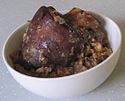
|
Typically smoked or boiled, ham hocks generally consist of much skin, tendons and ligaments, and require long cooking through stewing, smoking or braising to be made palatable. The cut of meat can be cooked with greens and other vegetables or in flavorful sauces. |
| Hog jowl | 
|
Cured and smoked cheeks of pork. It is not actually a form of bacon, but is associated with the cut due to the streaky nature of the meat and the similar flavor. Hog jowl is a staple of soul food,[18] but is also used outside the United States, for example in the Italian dish guanciale.[19][20] |
| Hog maw | 
|
The stomach lining of a pig; it is very muscular and contains no fat. As a soul food dish, hog maw has often been coupled with chitterlings, which are pig intestines. In the book Plantation Row Slave Cabin Cooking: The Roots of Soul Food hog maw is used in the Hog Maw Salad recipe.[21] |
| Chitlins |  |
Chitterlings (also known as chitlin's) are cleaned pig intestines; they are cooked in a pot and seasoned. The Hausa people in West Africa eat chicken intestines. Enslaved Africans in the American South continued their traditions of cooking, seasoning, and eating animal innards. Enslaved people added extremely hot peppers for additional flavor and spice to their chitlins. The parts of the pig that white plantation owners did not eat they gave to the enslaved which they used to season food and prepared one-pot meals, soups, and chitlin dishes.[22][23] |
| Oxtail[1] | 
|
The tail of cattle, oxtail is a bony, gelatin-rich meat, which is usually slow-cooked as a stew[24] or braised. |
| Pickled pigs' feet[16] | 
|
Slow cooked, sometimes pickled or often eaten with a vinegar based sauce. |
| Pigs' feet | 
|
Pigs' feet in soul food is a European influence as they are eaten in Europe. African Americans use pigs' feet to season their vegetables. Also during slavery, some white plantation owners gave the parts of the pig they did not eat to their slaves.[25][26] The feet of pigs: the cuts are used in various dishes around the world, and their usage has increased in popularity since the late-2000s financial crisis.[27] |
| Pork | 
|
As a meat dish, such as ham and bacon, and for the flavoring of vegetables and legumes, gravies and sauces. |
| Pork ribs | 
|
The ribcage of a domestic pig, meat and bones together, is cut into usable pieces, prepared by smoking, grilling, or baking – usually with a sauce, often barbecue – and then served. The method of barbecuing is of Native American and West African influence. The Hausa word for barbecue is babbake.[28] West Africans brought their methods of barbecue and making barbecue sauce to North America. African Americans use Native American and West African techniques of barbecue.[29][30][31] |
| Poultry | 
|
Giblets, such as chicken liver and gizzards.[16][17] Pictured is a chicken gizzard dish. |
| Shit on a Shingle |  |
Chipped beef with a bechamel sauce, served on toast. Additional toppings, gravy, or beef stock may also be added. |
| Turkey | 
|
Black Americans flavor their vegetables, collard and turnip greens using turkey necks. Turkey necks are placed in a pot of boiling water with greens and the fat from the meat adds flavor and seasoning to vegetables.[32] |
| Shrimp and grits |  |
Shrimp and grits is a seafood dish that was prepared by African Americans living near water sources such as the sea islands of South Carolina and Georgia and in Louisiana. This dish has become a common Southern dish prepared and eaten in different areas in the South.[33] |
| Gumbo |  |
Louisiana gumbo has influences from West African, French, Spanish, and Native American cuisines.[34] Gumbo in Louisiana has a roux for thickening and as a sauce. Gullah "gumbo" in the sea islands of South Carolina and Georgia is a tomato base.[35] |
Vegetables, legumes, seeds and fruits
Beans, greens and other vegetables are often cooked with ham or pork parts to add flavor.
| Name | Image | Description |
|---|---|---|
| Black-eyed peas | 
|
Black-eyed peas are native to Africa.[36] Often mixed into Hoppin' John or as a side dish.[1] Pictured are black-eyed peas with smoked hocks and corn bread. |
| Guinea pepper |  |
In 1748, Peter Kalm, a Swedish-Finnish botanist, noted enslaved Africans in Philadelphia cultivated guinea peppers, a hot pepper native to West Africa. The pods of the pepper were pounded and "mixed with salt preserved in a bottle" to make sauces poured over fish and meats.[37] |
| Kola nut |  |
The kola nut was brought from West Africa to North America by way of the slave trade.[38] Africans used it in their Orisha religious practices. Kola nuts were used to make Coca-Cola a carbonated soft drink.[39] |
| Watermelon |  |
Watermelon came from Africa to North America by way of the slave trade. Enslaved African Americans grew them in their gardens for food. Due to their red color, they are eaten during Juneteenth celebrations. The color red represents resilience and joy.[40][41] |
| Sesame seeds |  |
Sesame seeds are native to West Africa and were brought to South Carolina in 1730 by way of the slave trade. Enslaved and free Black people used sesame seeds to make sesame pudding, prepared stews, baked breads, and boiled their greens with sesame seeds. Slaves ate sesame raw, toasted, and boiled. It was used as an ingredient for baked breads in colonial America and is still used in the present day.[42] |
| Sea Island red peas |  |
Sea Island red peas are a variety of cowpea from West Africa brought to the sea islands of South Carolina during the slave trade. They are used in Gullah rice and bean dishes.[43] |
| Cayenne pepper |  |
Cayenne peppers are native to the Americas. Enslaved and free people used cayenne peppers to make a homemade barbecue sauce and was used to add heat and flavor to other dishes.[44] |
| Fish peppers |  |
Enslaved and free African Americans in the Chesapeake Bay area and in Baltimore, Maryland grew fish peppers in their gardens to add flavor and heat to their seafood dishes. Food historian Michael Twitty suggests fish peppers were brought to the United States from Haiti.[45][46][47] |
| Collard greens | 
|
A staple vegetable of Southern U.S. cuisine, they are often prepared with other similar green leaf vegetables, such as kale, turnip greens, spinach, and mustard greens in "mixed greens".[48] They are generally eaten year-round in the South, often with a pickled pepper vinegar sauce. Typical seasonings when cooking collards can consist of smoked and salted meats (ham hocks, smoked turkey drumsticks, pork neckbones, fatback or other fatty meat), diced onions and seasonings. |
| Hoppin' John[49] | 
|
A dish that originated in Gullah communities in the Low country region of South Carolina, but is now popular in many areas of the south,[50] consisting of black-eyed peas (or field peas) and rice, with chopped onion and sliced bacon, seasoned with a bit of salt.[51] Some people substitute ham hock, fatback, or country sausage for the conventional bacon; a few use green peppers or vinegar and spices. |
| Mustard greens | 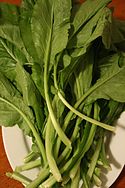
|
A species of mustard plant. Subvarieties include southern giant curled mustard, which resembles a headless cabbage such as kale, but with a distinct horseradish-mustard flavor. It is also known as green mustard cabbage. |
| Okra[52] | 
|
A vegetable that is native to West Africa, and is eaten fried or stewed and is a traditional ingredient of gumbo. It is sometimes cooked with tomatoes, corn, onions and hot peppers |
| Fried okra | 
|
Okra pods that have been sliced and dredged in cornmeal before frying. |
| Sweet potatoes | 
|
Often parboiled, sliced, then adorned with butter, sugar, cinnamon, nutmeg, vanilla or other spices, and baked; commonly called "candied sweets" or "candied yams"[16] |
| Turnip greens | 
|
Turnip leaves are sometimes eaten as "turnip greens", and they resemble mustard greens in flavor. Turnip greens are a common side dish in southeastern US cooking, primarily during late fall and winter. Smaller leaves are preferred; however, any bitter taste of larger leaves can be reduced by pouring off the water from initial boiling and replacing it with fresh water. Varieties specifically grown for the leaves resemble mustard greens more than those grown for the roots, with small or no storage roots. |
| Corn |  |
During slavery, corn was part of enslaved African Americans diet. Slaveholders provided cornmeal to their slaves to make meals. Corn was used by enslaved people to make corn bread, hominy, and boiled corn.[53] African Americans learned from Indigenous people/Native Americans how to make ash cake, "hoe cakes", and porridge from corn.[54] |
Breads and grains
| Name | Image | Description |
|---|---|---|
| Charleston red rice | 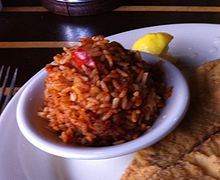 |
Charleston red rice is made with rice and tomato paste. The dish was created in the Gullah Geechee community. Charleston red rice originated from jollof rice in West Africa, which is made with a tomato product giving the rice its red color.[55] |
| Cornbread[56] | 
|
A quickbread often baked or made in a skillet, commonly made with buttermilk and seasoned with bacon fat; inspired by the great availability of corn in America. Cornbread is of Native American origin. Traditional southern cornbread is baked in European cake and bread baking style. Pictured is skillet cornbread. |
| Grits[57] | 
|
A cooked coarsely ground cornmeal of Native American origin. |
| Hoecake[1] | 
|
Also known as Johnnycake, a type of cornbread that is thin in texture, and fried in cooking oil in a skillet, whose name is derived from field hands' often cooking it on a shovel or hoe held to an open flame. |
| Hushpuppies[1] | 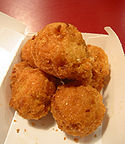
|
Balls of deep-fried cornmeal, usually with salt and diced onions. Typical hushpuppy ingredients include cornmeal, wheat flour, eggs, salt, baking soda, milk or buttermilk, and water, and may include onion, spring onion (scallion), garlic, whole kernel corn, and peppers. |
| Rice |  |
A species of rice was domesticated in Africa, so many people brought to the Americas during the slave trade preserved rice cooking techniques from West Africa. Rice is a staple side dish in the lowcountry region and in Louisiana. It is a main ingredient in dishes such as jambalaya and red beans and rice popular in Southern Louisiana.[58][59] |
Desserts
| Name | Image | Description |
|---|---|---|
| Sweet potato pie[1][15] | 
|
Parboiled sweet potatoes, then pureed, spiced, and baked in a pie crust, similar in texture to pumpkin pie. A traditional dessert in African American families during Thanksgiving and Christmas holidays is making and eating sweet potato pie.[60] |
| Banana pudding[61] | 
|
Pudding made with vanilla custard, vanilla wafers, bananas, whipped cream and vanilla extract |
| Red velvet cake[62] | 
|
Red colored cake made with cocoa powder. Red food and drinks are traditional during Juneteenth celebrations, including red velvet cake. The color red represents resilience and joy.[63][64][65] |
| Pecan pie[66] | 
|
Pie made with pecans |
Regional Soul Food
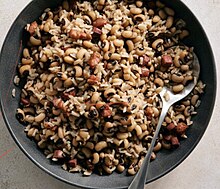
These are more specific regional Soul food dishes.This includes dishes like Jambalaya, Gumbo, red rice and beans and other foods of the creole subgroup of the Black American ethnic group. It also includes the dishes of the Gullah Geeche sub group of the Black American peoples. See: Louisiana Creole cuisine and Gullah Geeche cuisine.
Chicken and waffles became a common soul food item in Black communities in Maryland and in Harlem, New York. During the blues and jazz era, musicians and singers ate at soul food restaurants located inside black-owned night clubs and cooks prepared chicken and waffles for their customers.[68][69]
See also
- List of American foods
- List of foods of the Southern United States
- Louisiana Creole cuisine
- List of American desserts
References
- ^ a b c d e f g h Opie, Frederick Douglass (2008). Hog and Hominy. Columbia University Press. p. 133. ISBN 978-0231146388. Retrieved June 29, 2009.
- ^ Ferguson 1993
- ^ Holloway, Joseph. "African Crops and Slave Cuisine". Slave Rebellion Info. Slave Rebellion Website. Retrieved 31 May 2024.
- ^ "Diet and Nutrition". Santa Clara University Digital Exhibits. Santa Clara University. Retrieved 21 June 2024.
- ^ Blassingame, John (1972). The Slave Community: Plantation Life in the Antebellum South. Oxford University Press. pp. 39, 155–158. ISBN 9780195025637.
- ^ Brown, Shayla (2020). "Slavery, Soul Food and the Power of Black Women". North Jersey News. Retrieved 3 June 2024.
- ^ Blalock, Bob (2019). "African-Americans have shaped Alabama's and America's cuisine". Alabama News Center. Retrieved 6 July 2024.
- ^ "Seeds of Survival and Celebration: Plants of the Black Experience" (PDF). Cornell Botanical Gardens. Retrieved 16 June 2024.
- ^ Bower, Anne (2009). African American Foodways Explorations of History and Culture. University of Illinois Press. p. 162. ISBN 9780252076305.
- ^ Willhoite, Kenneth (2018). The Soul Food Museum Story Celebrating 400 Years of Culinary Arts Hospitality and Agriculture. Arthur House. ISBN 9781546225140.
- ^ "Black Foodways and Cuisine". National Museum of African American History and Culture. Smithsonian Institution. Retrieved 30 June 2024.
- ^ Davis, Donald (2006). Southern United States: An Environmental History. Bloomsbury Publishing. p. 130. ISBN 9781851097852.
- ^ Carney, Judith (2013). "Seeds of Memory: Botanical Legacies of the African Diaspora" (PDF). African Ethnobotany in the Americas: 15, 20. Retrieved 6 June 2024.
- ^ "Serving up chicken & waffles". Los Angeles Business Journal. September 22, 1997. p. 1.
- ^ a b Feeney, Kelly (May 8, 2009). "Soul Food With a Secret". The New York Times. Retrieved March 27, 2013.
- ^ a b c d Timothy Williams In Changing Harlem, Soul Food Struggles 5, 2008 New York Times
- ^ a b Mike Royko FOOD NAGS CAN KILL ANYONE'S APPETITE July 20, 1994 Page: 3 Chicago Tribune
- ^ Gillespie, Carmen (2009). Toni Morrison: A Literary Reference to Her Life and Work. Infobase Publishing. p. 343. ISBN 9781438108575. Retrieved 28 July 2012.
- ^ Fabricant, Florence (September 13, 2011). "Pork Jowl With a Backwoods Whiff". New York Times. Retrieved July 27, 2012.
- ^ May, Tony (2005-06-01). Italian Cuisine: The New Essential Reference to the Riches of the Italian Table. Macmillan. p. 11. ISBN 9780312302801. Retrieved 28 July 2012.
- ^ "Plantation Row Slave Cabin Cooking: The Roots of Soul Food". Retrieved 2007-10-08.
- ^ Bower, Anne (2009). African American Foodways Explorations of History and Culture. University of Illinois Press. p. 51. ISBN 9780252076305.
- ^ Lowery, Sharelle (2014). "Chitlin's From Slave Food to Delicacy The Black American Kitchen". The Bay State Banner. Retrieved 9 June 2024.
- ^ Blumenthal, Heston (14 November 2003). "The twist in the tail". The Guardian. London. Retrieved 16 August 2012.
- ^ Ferguson, Sheila (1993). Soul Food Classic Cuisine from the Deep South. Grove Press. p. 51. ISBN 9780802132833.
- ^ Alan, Davidson (2006). The Oxford Companion to Food. Oxford University Press. ISBN 9780191018251.
- ^ Carmichael, Sri (21 October 2009). "Pig's trotters fly off the shelves as customers seek cheap meat cuts". The Evening Standard. Archived from the original on 24 October 2009. Retrieved 28 March 2013.
- ^ Twitty, Michael (2015). "Barbecue is an American Tradition – of Enslaved Africans and Native Americans". The Guardian. Retrieved 4 June 2024.
- ^ Miller, Adrian (2021). "How the long history of black barbecue was erased". Independent. Retrieved 30 June 2024.
- ^ Miller, Adrian (2021). Black Smoke African Americans and the United States of Barbecue. University of North Carolina Press. pp. 22–25, 39–49, 50–57. ISBN 9781469662817.
- ^ Béchard, Deni. "The Bard of Barbecue". Stanford Magazine. Stanford University. Retrieved 30 June 2024.
- ^ Thomas, Clarence (23 February 2024). "Soul food roots: West Africa in Central Georgia kitchens". Macon Magazine. Retrieved 26 May 2024.
- ^ Necole, Shaunda. "Black Folks Southern Shrimp And Grits Recipe". The Soul Food Pot. Retrieved 7 July 2024.
- ^ "Gumbo combines African Native American French Spanish | Classic Chicago Magazine". classicchicagomagazine.com. Retrieved 2022-12-09.
- ^ Donaldson, Tara. "Gullah-Geechee Cuisine Is Finally Getting Its Due in Charleston". www.afar.com. Afar. Retrieved 7 July 2024.
- ^ "Origins of Soul Food". Suny Schenectady County Community College. Begley Library. Retrieved 3 June 2024.
- ^ Houck, Brenna. "Regional Barbecue Sauce Styles, Explained". Eater. Retrieved 30 June 2024.
- ^ Jahannes, Naftal (2021). "Black influences have shaped American food for centuries". Savannah Morning News. Retrieved 7 July 2024.
- ^ Sprague, Kevin. "The kola nut: West African commodity in the Atlantic world". www.nhlrc.ucla.edu. UCLA university. Retrieved 7 July 2024.
- ^ Mekouar, Dora. "How Enslaved Africans Helped Invent American Cuisine". www.voanews.com. VOA News. Retrieved 7 July 2024.
- ^ Amen, Sunyatta (June 10, 2022). "For Juneteenth, this hibiscus red drink is steeped in history". Washington Post. Archived from the original on July 5, 2022. Retrieved November 25, 2022.
- ^ Holloway, Joseph. "African Crops and Slave Cuisine". Slave Rebellion. Retrieved 7 July 2024.
- ^ Townsend, Bob (2019). "Recipes that celebrate the culinary history of the African diaspora". The Atlanta Journal-Constitution. Retrieved 16 June 2024.
- ^ Bower, Ann, etl. (2009). African American Foodways: Explorations of History and Culture. University of Illinois Press. pp. 29, 33–34. ISBN 9780252076305.
{{cite book}}: CS1 maint: multiple names: authors list (link) - ^ "Fish Peppers". www.chesapeakebaymagazine.com. Chesapeake Bay Magazine. 28 July 2020. Retrieved 21 June 2024.
- ^ Larson, Zeb (2024). "The US pepper that was nearly lost". BBC News. Retrieved 21 June 2024.
- ^ Intern, Waxter (28 July 2017). "Maryland Food History: The Fish Pepper". Preservation Maryland. Retrieved 21 June 2024.
- ^ Diana Rattray, About.com Guide (2012-04-10). "Mixed Greens - Recipe for Greens". Southernfood.about.com. Retrieved 2012-07-26.
- ^ "On New Year's Day, it gets the full Southern treatment, which usually means Hoppin' John – a traditional Soul Food fixin' consisting of F peas cooked with ham hocks and spices, served over rice. In the South, eating field-peas on New Year's is thought to bring prosperity" Celebrate New Year's with Field- peas by Rachel Ellner December 31, 2008 Nashua Telegraph
- ^ Smith Miles, Suzannah (22 December 2014). "Hoppin' John". www.charlestonmag.com. Charleston Magazine. Retrieved 20 May 2024.
- ^ Hoppin John What's cooking America.Another name for it is Stew Peas
- ^ Marcus, Jacqueline B. (2013). Culinary Nutrition: The Science and Practice of Healthy Cooking. Academic Press. Page 547. ISBN 0123918839
- ^ "A 19th Century Slave Diet" (PDF). www.nps.gov/bowa. The National Park Service. Retrieved 24 May 2024.
- ^ "Seeds of Survival and Celebration: Plants of the Black Experience" (PDF). Cornell Botanical Gardens. Retrieved 16 June 2024.
- ^ "Discover the History of Charleston in Three Mouthwatering Meals". Smithsonian Magazine. Smithsonian Institution. Retrieved 25 May 2024.
- ^ St. John, Warren (October 6, 2004). "Greens in Black and White". The New York Times. Retrieved March 28, 2013.
- ^ Ferguson 1993, pp. 25-26.
- ^ Jao, Carren. "A brief look at Black American history told through 10 food traditions". www.abqjournal.com. Albuquerque Journal. Retrieved 3 June 2024.
- ^ "Origins of Soul Food". Suny Schenectady County Community College. Begley Library. Retrieved 3 June 2024.
- ^ "Seeds of Survival and Celebration: Plants of the Black Experience" (PDF). Cornell Botanical Gardens. Retrieved 16 June 2024.
- ^ 7 Soul Food Dessert Recipes You Have To Try
- ^ Dessert
- ^ Cite error: The named reference
NYTfoodwas invoked but never defined (see the help page). - ^ Jaynes 2005.
- ^ Amen, Sunyatta (June 10, 2022). "For Juneteenth, this hibiscus red drink is steeped in history". Washington Post. Archived from the original on July 5, 2022. Retrieved November 25, 2022.
- ^ "Soul Food Dessert Recipes - Taste Like Grandma's".
- ^ Smith Miles, Suzannah (22 December 2014). "Hoppin' John". www.charlestonmag.com. Charleston Magazine. Retrieved 20 May 2024.
- ^ Opie, Frederick (2008). Hog and Hominy: Soul Food from Africa to America. Columbia University Press. ISBN 9780231146395.
- ^ Thomas, Amelia. "A Harlem soul food fix". www.bbc.com. BBC. Retrieved 9 June 2024.
Bibliography
- Ferguson, Sheila (1993). Soul Food: Classic Cuisine from the Deep South. Grove Press. ISBN 0802132839
Further reading
- Woods, Sylvia (1992). Sylvia's Soul Food. HarperCollins. ISBN 0688100120


Recent Comments